Vouvant
Vouvant (French pronunciation: [vu.vɑ̃]) is a commune in the department of Vendée, in the Pays de la Loire region in western France.
Vouvant | |
|---|---|
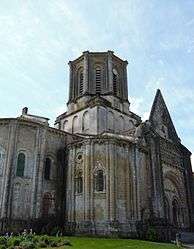 The Notre-Dame de l'Assomption church in Vouvant | |
 Coat of arms | |
Location of Vouvant 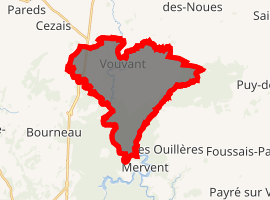
| |
 Vouvant  Vouvant | |
| Coordinates: 46°34′20″N 0°46′11″W | |
| Country | France |
| Region | Pays de la Loire |
| Department | Vendée |
| Arrondissement | Fontenay-le-Comte |
| Canton | La Châtaigneraie |
| Intercommunality | Pays-de-Fontenay-Vendée |
| Government | |
| • Mayor (2014-2020) | Jacky Roy |
| Area 1 | 20.20 km2 (7.80 sq mi) |
| Population (2017-01-01)[1] | 867 |
| • Density | 43/km2 (110/sq mi) |
| Time zone | UTC+01:00 (CET) |
| • Summer (DST) | UTC+02:00 (CEST) |
| INSEE/Postal code | 85305 /85120 |
| Elevation | 35–110 m (115–361 ft) |
| 1 French Land Register data, which excludes lakes, ponds, glaciers > 1 km2 (0.386 sq mi or 247 acres) and river estuaries. | |
Vouvant is labelled as Les Plus Beaux Villages de France (since 1988), Petite cité de caractère, and the village has obtained two flowers out of five in the Concours des villes et villages fleuris.
It is the only fortified village of Vendée. Its inhabitants are called Vouvantais. Over 10% of the population of Vouvant is British owing to a gradual occupation or purchase of real estate by English families.
Sites and monuments
Several sites and monuments are present in Vouvant :
- Walled enclosure of the Lusignan (dated between the end of the 12th century and the beginning of the 13th century) : the Tour Mélusine (keep of the castle), the fortifications around the village, the Postern Gate, etc. The Tour Mélusine has been protected as a monument historique by the French Ministry of Culture since 1927. The city fortifications has been protected as a monument historique since 1984.
- Notre-Dame de l'Assomption Church, classed as a monument historique in 1840 by Prosper Mérimée, built from the 11th century under the leadership of William V, Duke of Aquitaine : Théodelin's nave (11th century) / crypt (11th century, modified in the 12th century and rebuilt during restoration works in 1882-1884 for the ceiling) / square gable wall of the north portal, choir, apse and two small apses (second half of the 12th century) / triangular gable wall of the north portal and Gothic sculptures (1458-1464) / transept and the first three spans of the nave (wholly rebuilt during restoration works in 1882-1890).
- Medieval bridge (dated between the 13th and the 15th centuries), protected as a monument historique since 1927.
- Reproduction of the Grotto of Lourdes, on the bank of the Mère river. Realized in 1958.
- Public washing place.
- Forest of Mervent-Vouvant, Vendée's largest forest (5 518 ha).
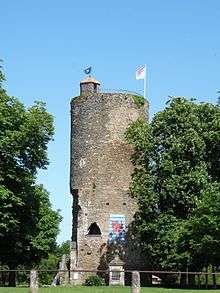 Tour Mélusine
Tour Mélusine Tour Mélusine
Tour Mélusine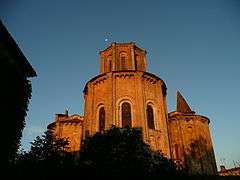 Notre-Dame de l’Assomption church
Notre-Dame de l’Assomption church- North portal of the church
- Théodelin's nave
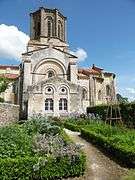 Jardin du prieuré
Jardin du prieuré Entrance of Vouvant
Entrance of Vouvant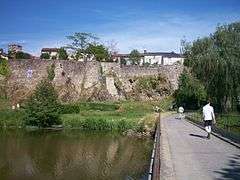 Fortifications and the Mère river
Fortifications and the Mère river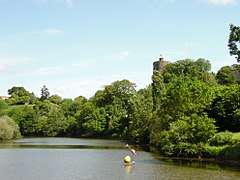 Mère river, with the Tour Mélusine in the background
Mère river, with the Tour Mélusine in the background- Postern Gate
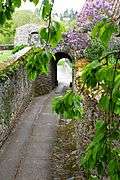 Postern Gate
Postern Gate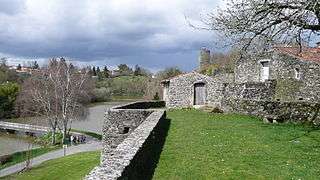 View from the Postern Gate
View from the Postern Gate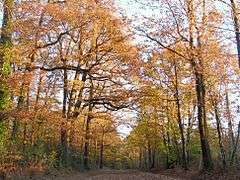 Forest of Mervent-Vouvant
Forest of Mervent-Vouvant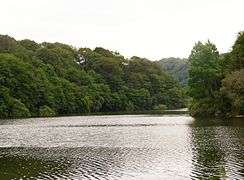 The river, in the heart of the forest
The river, in the heart of the forest
gollark: https://www.pnas.org/content/119/8/e2120481119
gollark: Well, yes.
gollark: You did, yes.
gollark: Maybe I should add baidicoot at some point. Oh well.
gollark: This is a server in which we occasionally discuss things.
See also
References
- "Populations légales 2017". INSEE. Retrieved 6 January 2020.
| Wikimedia Commons has media related to Vouvant. |
This article is issued from Wikipedia. The text is licensed under Creative Commons - Attribution - Sharealike. Additional terms may apply for the media files.